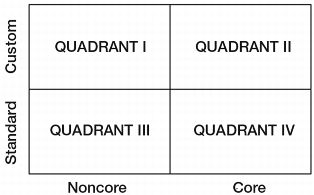A quadrant approach classifies Postal Service purchases into four categories, depending on their impact on the Postal Service core competencies (noncore versus core) and complexities (standard versus custom). Depending on the quadrant, performance-based contracts will be structured differently; examples of this are illustrated in Figure 2.10.
Figure 2.10
Quadrant Approach

Custodial — Performance-based contracts are appropriate. The standards identified are desired quality levels. The supplier’s technical proposals identify only the frequency and methods to be employed to meet the quality standard. The result is maximum flexibility for the suppliers.
Mail Transport Equipment (MTE) — Performance-based contracts are appropriate. The supplier is held to a standard of performance and is empowered to use best commercial practices and management innovation in performance. The contract does not specify how many supervisors, mechanics, or other members are required to be in a crew or on the job for servicing and maintenance of MTE.
Information Technology — Performance-based contracts have limited appropriateness. When developing a new system, the contract is for delivery of a working solution. Acceptance occurs only when the solution is successful, and payments are provided only when (and if) the solution delivers sufficient benefits to cover costs.
Transportation — Performance-based contracts are appropriate. For example, a supplier may be held to performance standards of on-time delivery, accuracy, and quality.
